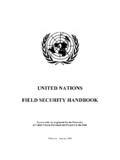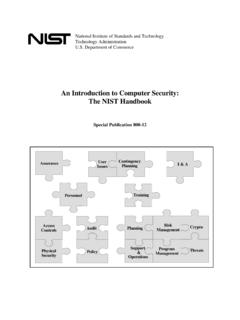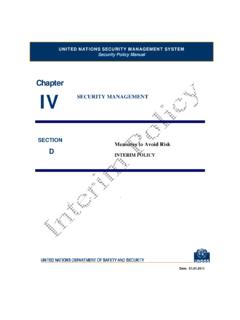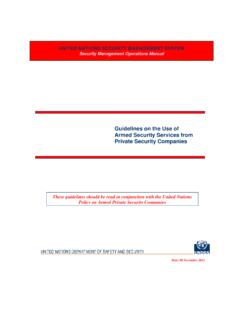Transcription of Chapter IV SECURITY MANAGEMENT - fao.org
1 SECURITY MANAGEMENT SECURITY Level System (SLS) INTERIM POLICY . Date: UNITED NATIONS SECURITY MANAGEMENT SYSTEM SECURITY Policy Manual Chapter IV SECTION B UNSMS SECURITY Policy Manual - 1 Chapter IV: SECURITY MANAGEMENT B. SECURITY Level System (SLS) Interim Policy A. Introduction: 1. The SECURITY Level System is a system for assigning a grade or level to areas where the United Nations operates in order to identify the overall level of danger in that area. The SECURITY Level System is a tool for United Nations SECURITY professionals to: a. More accurately identify and measure the level of SECURITY threat that exists in a geographic location, b. Produce a SECURITY Level (1-6) for that location, and c.
2 Give an overall impression to staff and managers of how the SECURITY environment in one area/location compares with another. B. Purpose: 2. The purpose of this policy is to outline the rationale for the SECURITY Level System and the relevant roles and responsibilities associated with it. C. Application/Scope: 3. The policy is applicable to all individuals covered by the United Nations SECURITY MANAGEMENT System, as defined in Chapter III of the SECURITY Policy Manual ( Applicability of SECURITY Arrangements ). D. Conceptual Framework: 4. The SECURITY Level System is an integral part of the SECURITY Risk MANAGEMENT process and is designed to accurately describe the SECURITY environment that exists in an area or location ( SECURITY Level Area ) in which the United Nations operates.
3 5. The SECURITY Level System is based on threat and not risk. The SECURITY Level System describes the general, threat-based SECURITY environment. Because SECURITY measurers must be designed to solve specific SECURITY problems, the SECURITY Level System is not used to make specific SECURITY decisions. The SECURITY Level System objectively describes the threat environment and uses this objective evaluation to inform the SECURITY Risk Assessment, from which SECURITY decisions are made. 6. A SECURITY Level is determined using a Structured Threat Assessment. The Structured Threat Assessment evaluates five categories: Armed Conflict, Terrorism, Crime, Civil Unrest and Hazards. Each category is evaluated using a point system, and the combination of these separate evaluations automatically determines the SECURITY Level.
4 The SECURITY Level indicates the level of danger that exists in the defined area or location on a scale of 1 to 6. UNSMS SECURITY Policy Manual - 2 Chapter IV: SECURITY MANAGEMENT B. SECURITY Level System (SLS) Interim Policy 7. To be reliable, a Structured Threat Assessment must have a clearly defined geographical area of analysis. It is rare for threats and hazards to be the same throughout an entire country, therefore most countries require more than one SECURITY Level Area . 8. The Structured Threat Assessment is updated anytime there is a significant change in the SECURITY environment, either an improvement or a worsening of the situation. The SECURITY Level System provides SECURITY decision makers with a very important snapshot of the existing threat-based environment in the defined area or location in which they need to operate.
5 All Structured Threat Assessments are conducted in the same way, so SECURITY decision makers receive the added value of being able to compare their locations with other locations in the world. E. SECURITY Levels 9. The SLS has 6 Levels, going from 1 (least dangerous environment) to 6 (most dangerous environment). In addition to numbers, the SECURITY Levels also have accompanying titles and colors as described in the attached annex. F. Roles and Responsibilities in the SECURITY Level System 10. All Chief SECURITY Advisors, SECURITY Advisors and Chief SECURITY Officers are responsible for preparing the Structured Threat Assessment, along with the SECURITY Cell, using all applicable threat-related information. 11. The Designated Official approves SECURITY Levels 1 to 5.
6 The Secretary General, through the Under-Secretary-General for Safety and SECURITY , approves Level 6. Upon approval, the SECURITY Level is recorded in the DSS database and automatically included in the DSS Travel Advisory. 12. The SECURITY Level System must be a standing agenda item for all SECURITY MANAGEMENT Team meetings, where the Designated Official, in consultation with the SECURITY MANAGEMENT Team, either confirms the Structured Threat Assessment as it stands, or approves any changes to it due to changes in the SECURITY environment, as per paragraph 7 above. 13. The Headquarters of the Department of Safety and SECURITY is responsible for validating all Structured Threat Assessments and resulting SECURITY Levels.
7 G. Training Requirements 14. Requirements for Basic SECURITY in the Field (BSITF) and Advanced SECURITY in the Field (ASITF) are not linked to SECURITY Levels. All United Nations personnel must successfully complete Basic SECURITY in the Field (BSITF) 1 Following the revision of the Basic SECURITY in the Field (BSITF) training, it will be renamed SECURITY for United Nations Personnel . At that time, all references in this policy to Basic SECURITY in the Field training or BSITF will be replaced with SECURITY for United Nations Personnel training. UNSMS SECURITY Policy Manual - 3 Chapter IV: SECURITY MANAGEMENT B. SECURITY Level System (SLS) Interim Policy United Nations personnel being assigned to, or visiting on official travel, any field location2, regardless of SECURITY Level, must successfully complete Advanced SECURITY in the Field (ASITF) training.
8 As noted in Chapter xx of the SECURITY Policy Manual entitled SECURITY Training , BSITF and ASITF certificates are valid for three years, at which point staff members must recertify. H. SECURITY Clearance 15. SECURITY clearance is required for all official travel to any location regardless of the SECURITY Level. The Designated Official has the delegated authority to grant SECURITY clearances for official travel to areas designated SECURITY Level 1 to 5. The Under-Secretary General for Safety and SECURITY may rescind this delegation as required. SECURITY clearance authority for areas in which SECURITY Level 6 is in effect is not delegated and will be granted only by the Under-Secretary General for Safety and SECURITY on behalf of the Secretary-General.
9 16. As explained in detail in Chapter xx of the Policy Manual, SECURITY Clearance Policy and the Travel Request Information Process, TRIP allows for both automatic and manual processes for granting SECURITY clearances. If the SECURITY plan for a certain location requires SECURITY clearance only to track traveller numbers and movement, then Designated Officials have the option of setting automatic clearances in TRIP. 17. When the SECURITY plan requires control over the number of travellers in a specific location, Designated Officials can set the TRIP system so that all official travel into a specific area has to be cleared manually. Manual SECURITY clearance procedures can be established at any location in any SECURITY Level if the Designated Official so requires it, and it is highly recommended that all areas in SECURITY Level 4 or higher have manual SECURITY clearance procedures.
10 I. Relocation and Evacuation: 18. The SLS does not deal with evacuation and relocation of staff or eligible family members. This issue is categorized as a risk MANAGEMENT option and is considered after the SECURITY Risk Assessment has been conducted. See SECURITY Policy Manual Chapter xx, entitled United Nations SECURITY Risk MANAGEMENT : Measures to Avoid Risk for the procedures on making relocation and evacuation decision, as well as for issuing All Agency Communiqu s to this effect. 2 For the purpose of this policy, field location is any location not designated as an H (Headquarters) duty station under the mobility and hardship scheme established by the International Civil Service Commission (ICSC).



















